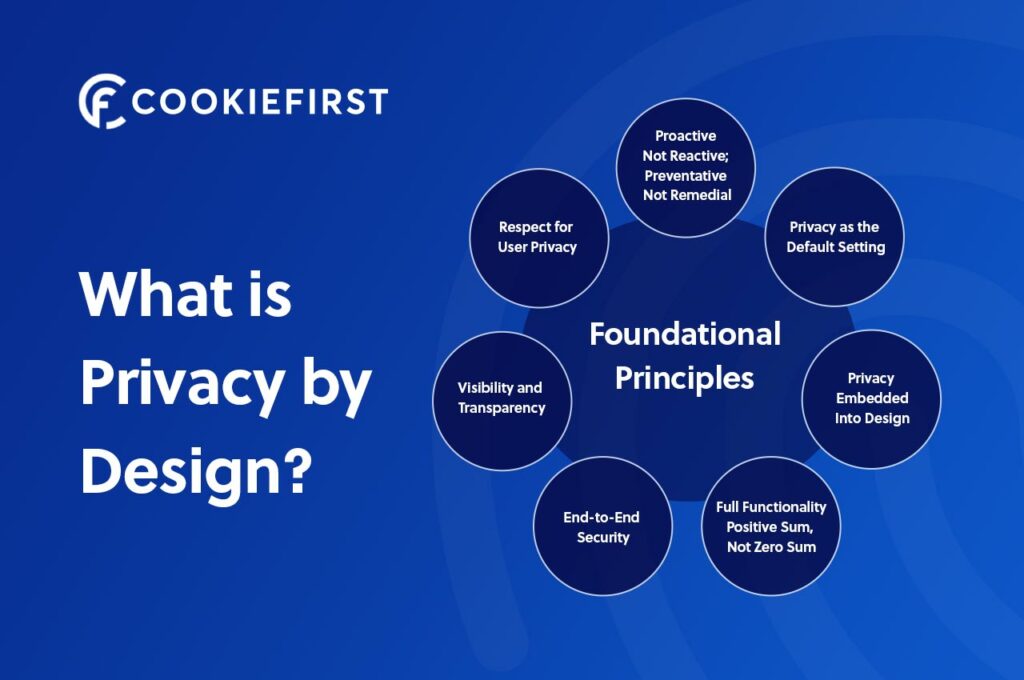Familiar with the world of cookie consent? Then chances are that you’ve heard the term ‘privacy by design’ before. This concept is a cornerstone of many data regulations around the world, and as such, has massive implications on the way online experiences work. In this article, we’ll discuss privacy by design in detail by covering its definition, origin, principles, and importance. We’ll also offer up some tips on how you can ensure your presence online complies.

Privacy by Design Explained
What Is ‘Privacy By Design’?
Privacy by design is a methodology that centers around collecting, storing, and using personal data ethically and responsibly. It was first proposed by Ann Cavoukian – then Information and Privacy Commissioner of Ontario, Canada – in 1995. Cavoukian argued that protecting individuals’ privacy should be an integral part of the design process for any product or service, and should be a priority from the beginning of the development cycle. Under the philosophy of privacy by design, security is an innate, assumed consideration. Everything else is built around it.
Principles Of Privacy By Design
Privacy by design is broken down into seven principles, each of which highlight an aspect of the theory’s guidance when it comes to data security. We’ve listed and explained them all below.
Principle #1: Proactive Not Reactive; Preventative Not Remedial
This first tenet underscores the value of taking a proactive approach to data privacy. It implies that risks are always out there, and should be addressed before they have the chance to manifest.
According to principle number one, organizations should take initiative in ensuring their practices are safe and to not wait for something serious to occur before making changes. This may look like conducting risk assessments or regularly auditing data protocols.
Principle #2: Privacy as the Default Setting
Privacy by design requires businesses to automatically set their relationships with users to the least invasive degree possible. The idea is that people should not be forced to take extra steps to protect their data; rather, that privacy should be the default and opt-in for access should follow. This second principle’s concept is key to many international data regulations. Prominent laws, such as the GDPR, require that companies do not automatically opt users into their services and that consent is instead ‘ambiguous and freely given.
Cookie Consent Manager | Take a 2 week free trial
Take a 2 week free trial for our paid plans or create a free account …
Principle #3: Privacy Embedded Into Design
Users face a slew of risks in today’s online landscape. It’s not hard for malicious hackers to gain access to data, especially if it is not properly stored and protected.
Privacy by design calls for the integration of security measures into the design of a product or service. This is usually done through encryption, data masking, and other methods. The goal here is to ensure that the privacy of a user is not compromised at any point.
Principle #4: Full Functionality – Positive Sum, Not Zero Sum
Digital design has long taken a zero-sum approach to the way it does things. The traditional view is that if something is secure, it cannot be user-friendly, and vice versa.
Privacy by design challenges this view; it suggests that security and convenience are not mutually exclusive. It holds that it’s possible for a product or service to function properly and remain secure at the same time, and that this should be the aim of all design processes.
Principle #5: End-to-End Security
This fifth principle speaks to the idea that organizations should strive for data security not just in certain areas, but across their entire system.
Data should be protected from the moment it is collected to the point of destruction. End-to-end security ensures that users’ data remains safe and secure at all times, no matter where in the system it is located.
Principle #6: Visibility and Transparency
One element of privacy by design that is often overlooked is visibility and transparency. Organizations should clearly articulate their data practices to the public, so users have a full understanding of how their data is used.
Although people often think of security as something that occurs only behind the scenes, it is also important to be open and honest about data protocols. This allows users to make informed decisions and feel a sense of trust in the organization.
Principle #7: Respect for User Privacy
Finally, the seventh principle of privacy by design calls for respect for user privacy. This means that companies should not use or exploit user data without permission and should take measures to ensure users are able to access, modify, or delete their own personal information. By respecting the rights of users, organizations can build trust and loyalty and create a better customer experience.
Are your an agency, web developer or another reseller?
Earn 30% commission, take a look at our reseller model or contact us for numbers larger than 500 clients
Remaining Compliant With the Principles of Privacy By Design
Privacy by design isn’t just some suggestion you can feel free to consider – it’s an absolute must for website owners in today’s system. Regulation upon regulation cites this principle and similar concepts as essential for data protection and compliance.
But what does privacy by design look like in practice? Here are a few tips to get started:
- Implement encryption measures for data storage and transfer.
- Create a privacy policy that outlines in detail the ways in which you use and protect user data.
- Be transparent about your data collection and storage practices.
- Allow users to access, modify, or delete their own personal data.
- Establish a robust system for monitoring and responding to potential breaches or threats.
- Invest in solutions that allow you to monitor and control your use of user data.
Ultimately, privacy by design is about recognizing that data is a valuable asset and must be treated as such. The responsibility is on organizations to take the necessary steps to protect it and ensure that individuals have control over how their information is used. By following the principles outlined here, organizations can ensure they are doing their part in promoting better digital safety and privacy.







